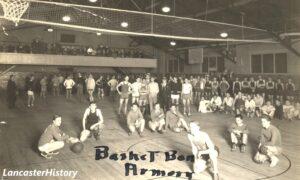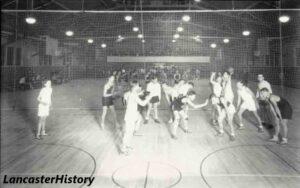A Brief History of the Stahr Armory
Planning for An Armory
438 North Queen Street, now home to Decades Lancaster, was originally known as the Lancaster Armory. The facility was renamed Stahr Armory in 1956. The Armory was constructed for use by the Pa. National Guard, an organization that traces its history all the way back to 1747 and Benjamin Franklin’s effort to create a volunteer organization known as The Associators – a group organized to provide a common defense against Indian raiders and French privateers.
The facility actually consists of two separate buildings – a one-and-one-half story drill hall constructed in 1928 and a front perpendicular administrative building constructed in 1937. It is one of a number of period armories designed on what is known as the T-Plan. The idea of building an armory in Lancaster was first proposed in January 1920. The idea was to construct both buildings at the same time. To that end, the national guard purchased this lot on North Queen Street for $25,200. The site was originally home to the S.E. Baily & Company carriage works and then to the Queen Motor Company which had recently been destroyed by fire.
Initial plans for the facility included a rear drill hall with space large enough to drill a battalion and an administration building with room to house offices, space for various veteran organizations and a war trophy room. Revenue for upkeep of the facility would be provided by rental fees for office space. The drill hall could be used for hosting sporting events – including wrestling, tennis, and basketball – as well as for raising funds by hosting social functions, exhibitions, and concerts.
While the national guard used the open air site for drilling purposes, construction of the planned buildings was delayed by recruiting shortfalls and by failure of the commonwealth legislature to approve funds. That situation changed in 1927 when the legislature passed a million dollar appropriation for the Armory Board. Included in that appropriation was $100,000 (or 10%) for construction of a drill hall. Construction of the administration building was to be financed by a separate bond.
Drill Hall
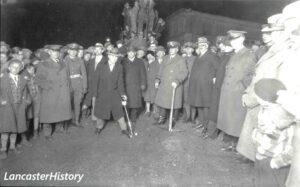
Philadelphia architect Philip H. Johnson (1868-1933) was selected to design the drill hall. In addition to hospitals, libraries, firehouses, and the Philadelphia Civic Center, Johnson also designed a number of other National Guard armories. Johnson’s design called for a facility measuring approximately 80 feet by 153 feet with brick walls. A lower level provided space for storage and garages. The design also called for a wooden first floor and a roof supported by steel arch trusses.
In November of 1927, John P. Snyder of Selinsgrove was selected as general contractor. Construction of the building began in January 1928. A number of local companies were hired to work on the building. Barton B. Martin & Company, lumber and coal yard located at 519 North Charlotte Street in Lancaster supplied the lumber for this beautiful ceiling. B. B. Martin Company was purchased by J.C. Snavely & Sons in 1972.
Administration Building
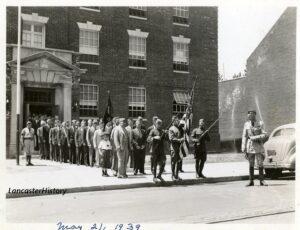
Despite repeated efforts to secure funding for construction of an administration building, securing approval proved to be challenging. Finally, in March of 1937, federal funds authorized through the WPA (Works Progress Administration) allowed the national guard to award a contract to Philadelphia architect partners H.C. Hodgens and A.D. Hill of Philadelphia to design the attached three-story administrative building in the colonial revival style. The basement of the administrative section included a rifle and pistol range.
Construction on the building began in October 1937. John R. Rauff Company, Baltimore served as the general contractor. Local companies involved in the construction included Everts & Overdeer, heating & ventilating and Musselman & Schwartz, plumbing.
At some time in the past, the balcony overlooking the drill hall on the east side was converted into second floor office space. In 1971, a 65 feet X 20 feet classroom was built onto the rear interior wall of the drill hall. The armory was added to the National Register of Historic Places in 1991.
The Pennsylvania National Guard left the armory in 2009 and relocated to a new facility in Mount Joy Township. The Theatre of the Seventh Sister used the building for several years as did several other small tenants that sublet space in the building. The facility closed in 2012 and was eventually purchased by the present owners who opened Decades in 2019.
Charles P. Stahr
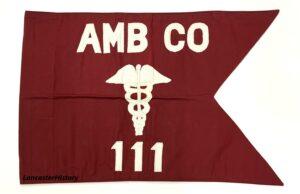
In 1956, the Lancaster Armory was renamed the Brigadier General Charles P. Stahr Armory in honor of local physician and Pa National Guard member Dr. Charles Patterson Stahr. Born in 1877, Stahr attended Franklin and Marshall College and received his medical degree from the University of Pennsylvania in 1900. As a first lieutenant he participated in the Mexican Border Campaign of 1916-1917 as a member of the Medical Corps of the Pennsylvania National Guard. In May of 1917, shortly after the entry of the United States into World War I, Lt. Stahr organized Ambulance Company Number 3 of the Pennsylvania National Guard.
When the entire National Guard was drafted into federal service as part of the war effort, the company was redesignated as Ambulance Company Number 111 of the 103rd Medical Battalion of the 28th Division under the command of Captain Stahr. The unit participated in a number of major engagements of the 28th Division in France during the war.
The 28th Infantry Division, also known as the “Keystone Division,” is the oldest continuously serving division in the United States Army. It was formed in 1879 as the 2nd Brigade of the Pennsylvania National Guard. In World War I the division became famous for its stand on July 15, 1918 along the Marne River. The 28th Division also participated in the Battle of the Bulge during World War II as well as in more recent conflicts including the Persian Gulf War, Operation Desert Storm, and the Iraq War. Today, the 28th Infantry Division is part of the Pennsylvania, Maryland, Ohio, and New Jersey Army National Guard.
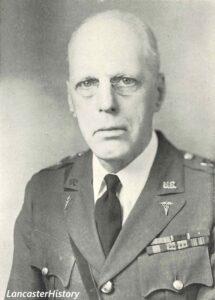
According to local sources, Stahr was known simply as “The Skipper” to those who served with him. When he returned home with his unit he is reported to have said, “Lancaster, here are your boys. I’ve brought them back to you.”
Stahr mustered out of federal service in May 1919. He re-entered service in the Pa. National Guard as a major in the Medical Corps in May 1923. He was promoted to Lt. Colonel in 1925 and full Colonel in 1935. He was called back to active duty as division surgeon for the 28th Division at the outbreak of World War II but retired shortly thereafter. He was promoted to the rank of Brigadier General in the Pa. National Guard on February 3, 1956 – the same date this building – the local National Guard Armory – was renamed in his honor. General Stahr died in 1962 at the age of 85.
Dr. Stahr was also active in community affairs. A native Lancastrian he attended Franklin and Marshall College. After receiving his medical degree from the University of Pennsylvania in 1900 he returned to Lancaster and served on the staff of the Lancaster General Hospital. He served as medical director from 1919 until 1940. He became the first medial inspector of the Lancaster Public Schools where he introduced a diphtheria vaccination program. He served as secretary of the Lancaster City Board of Health where he successfully introduced regulations regulating milk processing, restaurant sanitation, and water treatment. He was also deputy coroner for the city of Lancaster for more than 20 years.
Franklin & Marshall College – Stahr Hall
Those of you with a good memory might remember that Franklin and Marshall College also once had a building named in honor of a member of the Stahr family. Stahr Hall, now Stager Hall, was originally constructed between 1900 and 1902 as the Science Building. It was later remolded and the name changed to honor Dr. John Summers Stahr (1841-1915), father of Dr. Charles P. Stahr. The elder Dr. Stahr was a minister, professor, and scholar who also served as F&M President from 1890 until 1909. As a nod to the past, the main gathering space in the building is now called Stahr Auditorium.
On a Personal Note
General Stahr had one child, a daughter named Doris. Thomas Hicks, my maternal grandfather who also served in World War I and with the Pa National Guard, was also an ardent admirer of General Stahr. So much so, in fact, that he named his first daughter – my mother – Doris after the General’s own daughter and only child.
From Object Lessons

